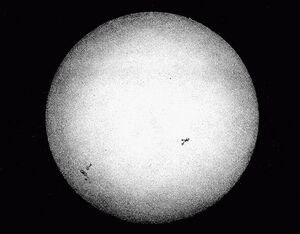Yggdrasil: Difference between revisions
Jump to navigation
Jump to search
Content added Content deleted
imported>Rox No edit summary |
imported>Rox No edit summary |
||
| Line 1: | Line 1: | ||
[[File:Yggdrasil.jpg|thumb|right|First image of Yggdrasil, captured around X [[Marphat calendar|CY]]]] |
[[File:Yggdrasil.jpg|thumb|right|First image of Yggdrasil, captured around X [[Marphat calendar|CY]]]] |
||
| − | '''Yggdrasil''' is the star at the center of the [[Solar system|solar system]]. It is a nearly perfect ball of hot plasma, heated to incandescence by nuclear fusion reactions in its core, radiating the energy mainly as visible light, ultraviolet light, and infrared radiation. It is by far the most important source of energy for life on [[Jotunnheim]]. Its diameter is about 1. |
+ | '''Yggdrasil''' is the star at the center of the [[Solar system|solar system]]. It is a nearly perfect ball of hot plasma, heated to incandescence by nuclear fusion reactions in its core, radiating the energy mainly as visible light, ultraviolet light, and infrared radiation. It is by far the most important source of energy for life on [[Jotunnheim]]. Its diameter is about 1.1 million kilometres (686,000 miles), or almost 87 times that of Jotunnheim. Its mass is about 243,000 times that of Jotunnheim, and it accounts for about X% of the total mass of the solar system. Roughly three quarters of Yggdrasil's mass consists of hydrogen (~73%); the rest is mostly helium (~25%), with much smaller quantities of heavier elements, including oxygen, carbon, neon and iron. |
[[Category:Astronomy]][[Category:Yggdrasil system]] |
[[Category:Astronomy]][[Category:Yggdrasil system]] |
||
Revision as of 07:40, 18 November 2021

Yggdrasil is the star at the center of the solar system. It is a nearly perfect ball of hot plasma, heated to incandescence by nuclear fusion reactions in its core, radiating the energy mainly as visible light, ultraviolet light, and infrared radiation. It is by far the most important source of energy for life on Jotunnheim. Its diameter is about 1.1 million kilometres (686,000 miles), or almost 87 times that of Jotunnheim. Its mass is about 243,000 times that of Jotunnheim, and it accounts for about X% of the total mass of the solar system. Roughly three quarters of Yggdrasil's mass consists of hydrogen (~73%); the rest is mostly helium (~25%), with much smaller quantities of heavier elements, including oxygen, carbon, neon and iron.